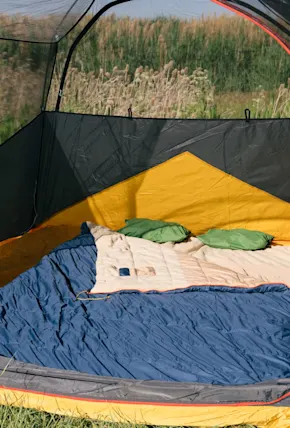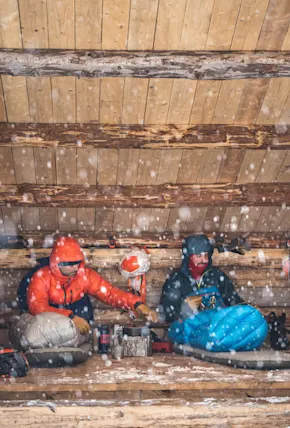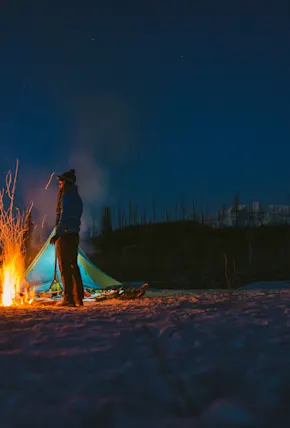How young is too young to start taking your kid camping? If you’re a parent, you hear the phrase, “Every kid is different,” all the time. The truth is you can take your kid camping at any age, it just may not be enjoyable until they’re “ready” for the outdoors. It’s a judgment call. I’m a parent and in my humble opinion, being ready just means having the right camping gear to make sure everyone is dry and comfortable, and that means your little one needs their own sleeping bag.
My daughter is three and our family camping trips started when she was around seven months old. (It was in a van, but it still counts.) We van-camped in Maine, Vermont, Western Pennsylvania, and from California up to British Columbia. When she was one, I started doing some tent camping with her. Wow, I had to pack a lot of extra stuff to make that happen, but it’s totally doable as long as you have the bed setup dialed. I’ve always followed three rules: Make sure it’s dry, warm, and flat. With that, you can pretty much get your kid to sleep anywhere.
The most important piece of gear to make camping work for a child is probably a dedicated kid's sleeping bag. Many of the top camping brands make child-specific bags that work in all elements. It’s also super fun for a kid to have their own sleeping bag that they can also use in the living room or at sleepovers. Many kid's sleeping bags range between $30 and $100 depending on the temperature rating, material, and other features.
Below we have a list of our top picks for the 9 best kids sleeping bags, and further on, a full breakdown of what to look for in a kids sleeping bag. But first, a quick reminder on the different shapes you'll encounter when shopping for a sleeping bag for your little one.

Photography by Nate Stephenson
Kids Sleeping Bag Shapes
Just like with the adult versions, kids' sleeping bags come in different shapes, and the same rules apply.
Rectangular sleeping bags are roomy and often more affordable but don't provide a lot of warmth. They work great for indoor camping or a slumber party, especially if your child likes a bit more space.
Modified mummy sleeping bags are slightly tailored to fit a human body better. Excess air pockets, and thus airflow, are eliminated to keep you warmer. They are great for outdoor camping in the summer when there's warm weather, and they pack down slightly smaller.
Full Mummy-style sleeping bags are more specifically shaped to fit around your child's body. Mummy-style sleeping bags provide optimal heat retention and pack down small, though they are more restrictive and aren't ideal for kids who toss and turn in the middle of the night. Full mummy bags are best for camping in cold weather.
The 9 Best Kids Sleeping Bags We Tested
Best Overall: REI Co-op Kindercone 25
If you’re taking your kid camping somewhere cold or potentially wet, this is a great camping sleeping bag. It’s filled with synthetic and tested for temps as low as 25F. It is made of a recycled polyester shell that provides solid water resistance. And it features all the modern design features, like a contoured hood shape, expanded foot box, and stuff sack. If you're looking for an option for bigger kids, REI makes a synthetic insulation sleeping bag for kids age 11 - 17 called the Zeyphr 25 ($149) that's also rated to 25 degrees and is adjustable.
Temperature Rating: 25°F
Length: 66"
Material: Recycled polyester (bluesign® approved), synthetic insulation
Price: $70 $49
Best Budget Option: Coleman Blue Bandit
The Blue Bandit is a Coleman kids sleeping bag rated to 30 degrees that comes with a great price point, but it doesn't lack for features. It’s a mummy shape with a patterned inside liner that’s compatible and machine washable. It also has a snag-proof zipper and an interior pocket. As a product by the legacy brand, Coleman, it also comes with a great warranty.
Temperature Rating: 30°F
Length: 60"
Material: polyester shell, synthetic (polyester) insulation
Price: $50 $35
SHOP From CampMor
Best for Restless Sleepers: Marmot Kids' Trestles Elite Eco 30
Marmot's adult-sized Trestles is a best seller, and the kids version of the sleeping bag is probably the best bargain on the market this season. It’s lightweight, packable, comfy, and low-impact with 100% recycled synthetic insulation. It's also tested for warmth at freezing level. As for features, it’s got zippers on both sides so kiddos can unzip and fold down the front when they don’t want to be confined or it gets too hot, and a secret stash pocket.
Temperature Rating: 30°F
Length: 60"
Material: recycled polyester shell and lining, synthetic insulation
Price: $119 SHOP from Public Lands
Best For Sleeping in a Tent: Big Agnes Wolverine
As a brand, Big Agnes is tested true for camping essentials in all kinds of weather and environments. The Wolverine 15-degree sleeping bag is a mini version of an adult bag, with a fun pattern added to the inside. The coolest feature is the attached half-pad retainer that secures the sleeping bag to a sleeping pad or mattress, so your child doesn’t wiggle their bag off onto the ground while they sleep.
Temperature Rating: 20°F
Length: 56"
Material: polyester shell and lining, recycled insulation
Price: $120
SHOP from Backcountry
Best Eco-Friendly Kid's Sleeping Bag: The North Face Youth Eco Trail
The North Face is no stranger to making sleeping bags, and recently, they’ve been leveraging decades of design experience to incorporate recycled and eco-friendly materials. The Eco Trail sleeping bag uses 100% recycled materials and comes in a youth model that’s warm and comfortable for camping and sleepovers. It has all the necessary features for an outdoor adventure, including enough width for shifting around in the night, a J-shaped zipper for solid ventilation, an internal pocket for easy accessibility to small items, and loops for connecting it to a sleeping pad.
Temperature Rating: 20°F
Length: 60"
Material: polyester shell, lining, and insulation
Price: $119 $83
SHOP from Amazon
Most Premium Down Sleeping Bag for Kids: Feathered Friends Fledging YF
This is an awesome sleeping bag from a great brand that’s focused on quality and design (we recommend Feathered Friends for adults looking for high-grade down sleeping bags). Available in 20F or 30F temperature ratings, the Fledging YF children’s sleeping bag is a classic mummy shape that’s warm, lightweight, and built for all types of camping weather. It uses premium 900-fill goose down so it packs down incredibly well, but that also makes it a pricier option.
Temperature Rating: 20°F or 30°F
Length: 60"
Material: Pertex YFuse shell, Pertex nylon lining, 900+ down insulation
Price: $369 SHOP From Feathered Friends
Best Three-Season Kid's Sleeping Bag: Kelty Mistral
The Mistral Kids sleeping bag from Kelty is tested to 20F. It’s a kid-sized model of an adult sleeping bag Kelty makes that includes a packed out foot box and CloudLoft insulation to keep the child sleeper warm and dry in a damp camping climate. It’s lightweight enough at 2.65 lbs and comes with a quality stuff sack. The best party about the Mistral Kids though? The price!
Temperature Rating: 20°F
Length: 69"
Material: polyester shell and lining, synthetic insulation
Price: $60 SHOP NOW
Best Mummy-Style Kid's Sleeping Bag: Mountain Hardwear Youth Bozeman
Mountain Hardware’s Youth Bozeman sleeping bag is a one-time purchase for your kid’s entire childhood because it’s adjustable, thanks to an internal drawcord system. Meaning, as their experience camping in the outdoors grows, so will their sleeping bag. It’s got recycled synthetic insulation arranged to minimize cold spots, a cozy face gasket, and other smart design features that prove it’s built for the long term.
Temperature Rating: 20-40°F
Length: 54-66"
Material: Polyester shell, synthetic fill
Price: $100 SHOP From backcountry
Best for Toddlers: Morrison Outdoors Big Mo 20
With arms and a central zipper, Morrison Outdoors' Big Mo is a fun alternative to the traditional zippered-tube sleeping bag shape that's ideal for young kids who might be ready for camping but not a real sleeping bag. It's high-quality, too—the sleeping bag has a water-resistant nylon shell and super soft 650-fill duck down insulation that keeps it nice and packable. Morrison Outdoors also makes a version called the Little Mo ($160) for babies and the larger Mighty Mo ($200) for bigger kids aged 4-6.
Temperature Rating: 20°F
Length: 54"
Material: nylon shell and lining, 650-fill down insulation
Price: $180 SHOP From REI
The 3 Most Important Features of a Kid's Sleeping Bag
There are various features to look for when choosing the right sleeping bag for young campers. Kids' sleeping bags come in different shapes and sizes and provide varying degrees of warmth for colder nights.
Temperature Rating
Also as with adult sleeping bags, kid's sleeping bags come with temperature ratings that designate their optimal comfortable range of heat retention. These ratings could differ between models and brands and usually state the lowest temperature in which the bag will keep an average person warm. The temperature rating you go for greatly depends on the conditions in which you will be camping–and your child's preference. Some children naturally get hot during the night, while others may need some extra warmth, even in mild weather.
Generally, summer sleeping bags can keep your child comfortable in temperatures of 30°F and up. Three-season sleeping bags are best suited for temperatures between 10 and 40°F. Winter sleeping bags are designed to keep your kid warm when the weather drops to 15°F or lower.
A true winter sleeping bag will likely be too warm for your child to use during summer camping trips. Likewise, a summer sleeping bag would probably not provide enough warmth if you plan on going camping in the winter or late fall. When looking for a youth sleeping bag, consider one that suits the weather that your child will use it in the most.
Size
Yeah, it's obvious, but adult sleeping bags are not made for little people. The air pocket around your body inside the sleeping bag is what keeps you warm. However, if the sleeping bag is too big, larger volumes of air move in and out of the bag. This means more ventilation inside the sleeping bag. The movement of air draws away body heat, and each time air flows into the sleeping bag, your kid's body needs to heat up that air. This ends up doing the opposite of what the sleeping bag is supposed to do–keep your kiddo nice and toasty out in the tent.
Kids' sleeping bags come in limited sizes, generally. Kids or youth sleeping bags fit children up to five feet tall in most cases. Some youth sleeping bags could accommodate people up to 64-66 inches tall. Some sleeping bag manufacturers make smaller toddler sleeping bags for children up to around four or five years old. These bags are often labeled as "girl's" or "boy's" sleeping bags and can accommodate toddlers of any gender up to 42 inches tall.
It's possible to use an adult-size sleeping bag for your child, too, with one nifty hack: stuff the bottom with a pillow or clothing, or close it off by tying a drawstring or a large elastic band around the excess part at the bottom of the sleeping bag.
Materials
Steer clear of cheap Amazon brands and look for a kid's sleeping bag made from the same high-quality materials as an adult version. A water-resistant outer layer of polyester or nylon, a polyester-taffeta blend interior, a two-way zipper, down or synthetic insulation.
Down filling makes for the lightest, warmest, and most packable sleeping bags, but down-filled sleeping bags are more expensive and get cold and heavy when wet (down kid's sleeping bags are also a bit harder to come by). The other (more readily available) option is sleeping bags that use synthetic insulation. Sleeping bags with synthetic insulation are a bit heavier but work well in the cold and when they get wet. They are also more affordable–perfect for growing little campers.
Other Features
Kids sleeping bag manufacturers often include added features to their products to make your child even more comfortable. These features include hoods, pockets, pack straps, and stuff sacks. Hoods and pillow pockets are great because they provide some extra warmth around the head area. They also keep pillows in place, especially if your child will be sleeping on a mattress or a sleeping pad.
Pack straps and stuff sacks or compression sacks make it easy to pack away and carry the sleeping bag. This is especially handy if your child will be carrying their own sleeping bag when hiking, backpacking, or making their way to a campsite.
Another feature to consider is the zipper. Zippers that prevent the lining from catching are crucial for a kids' sleeping bag. They will make it easier for your child to get in and out of their sleeping bag by themselves. This kind of zipper also avoids panic during urgent midnight nature calls.
How to Clean a Kids Sleeping Bag
Your child's sleeping bag doesn't necessarily have to be washed after every use. In fact, washing a sleeping bag in the washing machine too often could deteriorate the quality of the materials and lead to a loss of insulation, especially if not done properly.
Instead, you can spot clean dirty areas with a toothbrush, soap, and water. Clean any obviously dirty areas and marks off the sleeping bag without immersing it in water. Baby wipes can also work. Try not to get the insulating material wet while you clean and rinse these areas, and allow the sleeping bag to air-dry afterward. If you do need to wash your kid's sleeping bag in the washing machine, don't use a machine with an agitator, and don't use fabric softener. Instead, use a technical fabric soap like Nikwax's Down Wash Direct for down-filled bags and Nikwax's Tech Wash for synthetic ones. Use your machine's delicate setting, or wash the sleeping bag by hand.
Sleeping bags, check. Lightweight chairs and stools for camping? Check here.
















